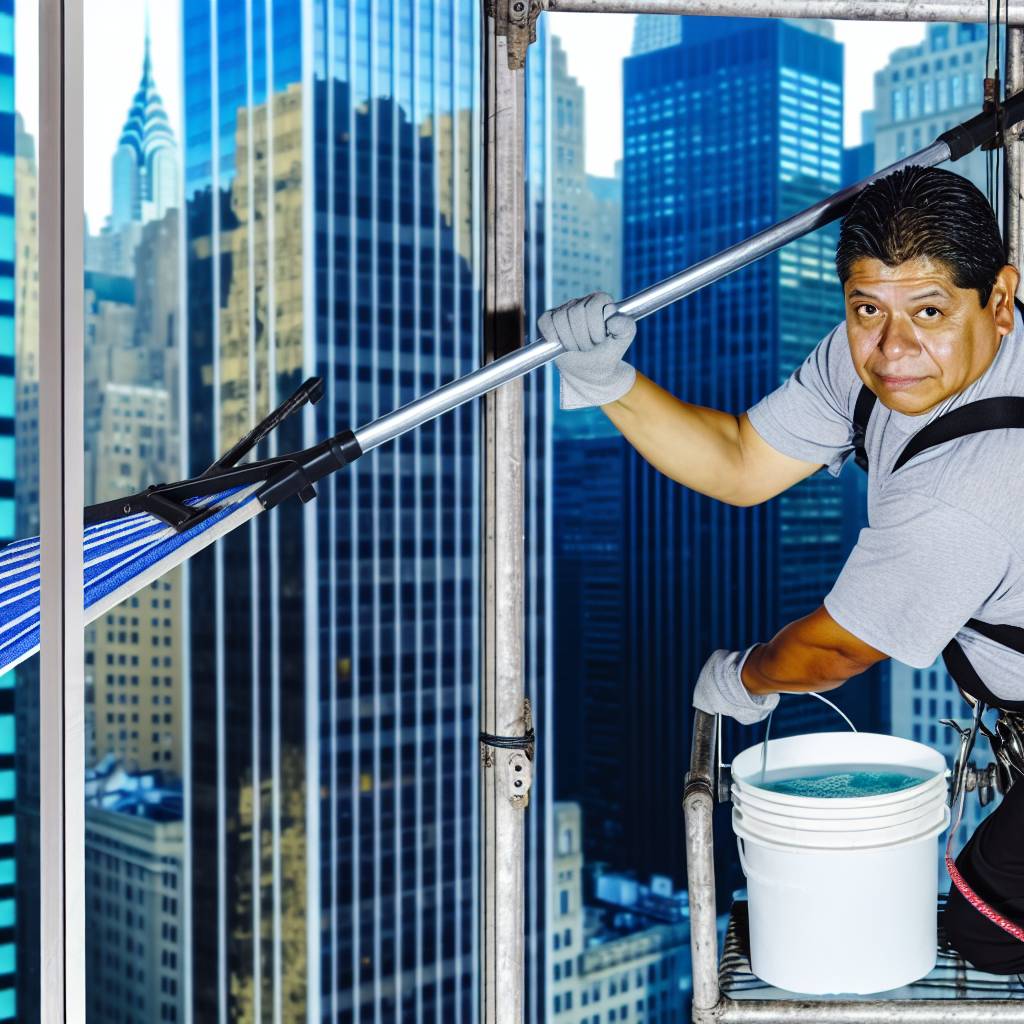Introduction:
Window cleaning is an essential part of home maintenance.
However, deciding between hiring a professional service or doing it yourself can be a tough choice.
Understanding the cost breakdown of both options is crucial in making an informed decision.
This blog post aims to break down the expenses involved in professional window cleaning versus a DIY approach.
It helps readers weigh their options and choose the best method for their needs.
Professional Window Cleaning Costs:
Hiring a professional service can cost anywhere from $150 to $500.
Factors such as the size of the house and the number of windows play a significant role in pricing.
A smaller home with fewer windows will be on the lower end of the cost spectrum.
A larger house with more windows will obviously cost more to clean professionally.
High-rise buildings or homes with hard-to-reach windows will also increase the price.
Factors that Influence Pricing:
The size of the house: Larger homes require more time and effort to clean.
The number of windows: More windows mean more work for the cleaning crew.
High-rise buildings: Cleaning windows on higher floors involves additional safety measures.
Accessibility: Difficult-to-reach windows will drive up the cost of professional cleaning.
Benefits of Hiring Professionals:
Expertise: Professional window cleaners have the training and experience to deliver high-quality results.
Convenience: Hiring professionals saves you time and effort, allowing you to focus on other tasks.
Equipment: Professional cleaners have access to specialized tools and products for effective cleaning.
Safety: Professionals are equipped to handle difficult-to-reach windows safely and securely.
Results: Professional cleaners can achieve a streak-free shine that is hard to replicate with DIY methods.
DIY Window Cleaning Supplies:
When it comes to DIY window cleaning, having the right supplies is essential for achieving a streak-free shine.
Transform Your Career Today
Unlock a personalized career strategy that drives real results. Get tailored advice and a roadmap designed just for you.
Start NowHere is a list of the essential supplies needed for DIY window cleaning:
List of Essential Supplies:
- Microfiber cloths: These are ideal for cleaning windows as they are lint-free and leave no streaks behind.
- Squeegee: A good quality squeegee will help you remove excess water and cleaning solution efficiently.
- Vinegar or ammonia-based cleaner: These are effective at cutting through grease and grime on windows.
- Bucket: You’ll need a bucket to mix your cleaning solution and for rinsing your tools.
- Dish soap: A few drops of dish soap can help break down dirt and grime on your windows.
- Newspaper or coffee filters: These can be used to buff your windows to a shine without leaving lint behind.
Estimate of Total Cost:
The total cost of purchasing these DIY window cleaning supplies can vary depending on the quality and brand of the products you choose.
On average, you can expect to spend around $20-$30 on these supplies.
Common Household Items as Substitutes:
If you’re looking to save some money, you can also use common household items as substitutes for commercial cleaning products:
- White vinegar: Dilute with water for a streak-free window cleaning solution.
- Lemon juice: The acidity in lemon juice can help dissolve tough grime on windows.
- Baking soda: Mix with water to create a paste for stubborn stains on windows.
- Cornstarch: Can be used to polish windows to a sparkling shine.
- Rubbing alcohol: Helps break down grease and evaporates quickly for streak-free windows.
Using these common household items as substitutes can help you save money on cleaning supplies while still achieving clean and sparkling windows.
So, consider giving DIY window cleaning a try with these essential supplies and substitutes!
Gain More Insights: Green Building: Eco-Friendly Drywall Options
Comparison of Labor Costs:
- Calculate the potential labor costs of hiring professionals versus doing it yourself.
- Factor in the time spent on cleaning and the hourly rate for professionals.
- Discuss the trade-offs between saving money and investing time in window cleaning.
When considering the comparison of labor costs between hiring professionals and doing it yourself for window cleaning, it is essential to look at the potential financial implications of each option.
Let’s break down the labor costs involved in both scenarios to help you make an informed decision.
Calculating Labor Costs:
When hiring professional window cleaners, the labor costs are straightforward – you will need to pay them an hourly rate for their services.
On average, professional window cleaners charge between $40 to $80 per hour, depending on the size of your home and the number of windows that need to be cleaned.
On the other hand, if you decide to tackle the window cleaning job yourself, you will need to factor in the time you spend cleaning.
If you value your time at a certain hourly rate, you can calculate the labor costs associated with doing it yourself.
Factor in Time Spent and Hourly Rate:
When determining the labor costs of DIY window cleaning, consider how long it will take you to clean all the windows in your home.
Take into account the number of windows, the difficulty of reaching them, and the equipment needed for the job.
If you typically charge $50 per hour for your professional services and it will take you approximately 5 hours to clean all the windows in your home, the labor costs of DIY window cleaning would amount to $250 (5 hours x $50 per hour).
Compare this to the cost of hiring professionals. If a professional cleaning service quotes you $200 to clean all your windows, it may be more cost-effective to hire them instead of doing it yourself.
Trade-Offs Between Saving Money and Investing Time:
When deciding between hiring professionals or doing it yourself for window cleaning, it ultimately comes down to a trade-off between saving money and investing time.
While hiring professionals may cost you more upfront, it can save you valuable time and ensure a thorough and professional job.
Showcase Your Business Today
Reach thousands of readers actively exploring professional services. Publish your business profile and grow your audience now.
Publish NowOn the other hand, if you have the time, energy, and skills to clean your windows yourself, you may be able to save money by taking on the task.
However, keep in mind that DIY window cleaning can be time-consuming and physically demanding, especially if you have a large house with many windows.
Gain More Insights: Pest Control Work: Legal and Ethical Issues
Quality of Results:
Professional cleaners typically achieve a higher quality of cleaning compared to DIY efforts.
They have advanced tools, equipment, and solutions to ensure streak-free and sparkling windows.
Professionals use techniques like squeegeeing, microfiber cloths, and specialized cleaning solutions.
Tips for Achieving Professional-Quality Results:
- Invest in high-quality squeegees, microfiber cloths, and professional cleaning solutions.
- Use a solution of water and vinegar or a professional-grade window cleaning solution.
- Start by removing dirt and dust with a microfiber cloth before using a squeegee for streak-free results.
- Clean windows on a cloudy day to prevent the cleaning solution from drying too quickly and leaving streaks.
Find Out More: Tips for Effective Communication with Clients

Additional Costs and Considerations:
- Identify additional costs that may arise when hiring professionals, such as travel fees or extra services.
- Discuss hidden costs associated with DIY window cleaning, such as potential damage to window frames.
- Offer suggestions for minimizing costs and maximizing efficiency in both options.
Identify additional costs for hiring professionals:
When you hire professionals to clean your windows, there are several additional costs that may arise.
One of the most common extra expenses is travel fees.
Depending on the location of your home or office, the professional window cleaners may charge a fee for travel time and transportation costs.
This can add up quickly, especially if your property is in a remote or hard-to-reach area.
In addition to travel fees, some companies may also charge extra for special services, such as cleaning screens or removing hard water stains.
These add-ons can significantly increase the total cost of the window cleaning service.
Hidden costs associated with DIY window cleaning:
While DIY window cleaning may seem like a cost-effective option, there are hidden costs that can quickly add up.
One of the biggest risks of DIY window cleaning is the potential damage to the window frames.
If you use the wrong cleaning solution or technique, you could end up scratching or discoloring the window frames, leading to costly repairs or replacements.
Additionally, if you don’t have the proper equipment or skills, you may not be able to clean the windows effectively, resulting in streaks or spots that require professional correction.
These mistakes can result in wasted time, money, and frustration.
Suggestions for minimizing costs and maximizing efficiency:
Whether you choose to hire professionals or do it yourself, there are ways to minimize costs and maximize efficiency in both options.
To reduce expenses when hiring professionals, consider scheduling regular window cleaning appointments to maintain the cleanliness of your windows and prevent the buildup of dirt and grime.
This can help extend the time between cleanings, saving you money in the long run.
Additionally, you can ask for quotes from multiple companies to compare prices and negotiate discounts or package deals.
When it comes to DIY window cleaning, invest in high-quality cleaning supplies and tools to ensure a thorough and streak-free clean.
Follow proper cleaning techniques and safety precautions to avoid damaging the windows or injuring yourself.
Consider using natural cleaning solutions, such as vinegar and water, to save money and protect the environment.
By taking these steps, you can achieve sparkling clean windows without breaking the bank.
See Related Content: Top Skills Every Successful Miner Must Have
Environmental Impact:
When it comes to professional window cleaning services, there are certain environmental impacts that need to be considered.
From water usage to chemical waste, these services can have a negative effect on the environment.
Water Usage:
- Professional window cleaning services often use large amounts of water to clean windows, especially for high-rise buildings.
- This excessive water usage can contribute to water scarcity and wastage, particularly in areas facing water shortages.
- Some professional cleaning companies may use pressure washers or hoses that further increase water consumption.
Chemical Waste:
- Many professional window cleaning companies use chemical-based cleaning solutions that can be harmful to the environment.
- These chemicals may end up in the soil or water sources, causing pollution and potentially harming aquatic life.
- Improper disposal of these chemicals can also lead to contamination of groundwater and soil, affecting biodiversity.
Eco-Friendly Alternatives:
- One eco-friendly alternative to professional window cleaning is to make your own cleaning solutions at home.
- Homemade solutions using ingredients like vinegar, baking soda, and water are effective and environmentally friendly.
- Using microfiber cloths or squeegees instead of paper towels can also reduce waste and minimize environmental impact.
Consider Sustainability:
- It is essential for readers to consider sustainability when choosing between professional and DIY window cleaning.
- Opting for eco-friendly cleaning methods not only benefits the environment but also promotes a sustainable lifestyle.
- By reducing water usage and chemical waste, individuals can make a positive impact on the environment and contribute to a greener planet.
Encouraging readers to prioritize sustainability and choose eco-friendly alternatives can help minimize the environmental impact of window cleaning, whether done professionally or DIY.
Choosing Between Professional and DIY Window Cleaning
When comparing professional versus DIY window cleaning, both options have their advantages and disadvantages.
The choice between the two methods comes down to personal preferences and budget constraints.
Additionally, the size of the project plays a significant role in the decision-making process.
It is important to evaluate your needs carefully.
Weigh the costs and benefits of each approach to determine the best course of action.
Regardless of the option you choose, regular window cleaning is essential.
This maintenance helps maintain the appearance and integrity of your home or business.
Therefore, investing the time and resources needed to keep your windows clean is recommended.
Additional Resources
Client asking for cost breakdown : r/woodworking
May 2023 National Occupational Employment and Wage Estimates
Showcase Your Business Today
Reach thousands of readers actively exploring professional services. Publish your business profile and grow your audience now.
Publish Now[E-Books for Sale]
The Big Book of 500 High-Paying Jobs in America: Unlock Your Earning Potential
$19.99 • 500 High-Paying Jobs • 330 pages
Explore 500 high-paying jobs in America and learn how to boost your career, earn more, and achieve success!
See All 500 High-Paying Jobs of this E-Book
1001 Professions Without a Degree: High-Paying American Jobs You Can Start Now
$19.99 • 1001 Professions Without a Degree • 174 pages
Discover 1001 high-paying jobs without a degree! Unlock career tips, skills, and success strategies for just $19.99!




